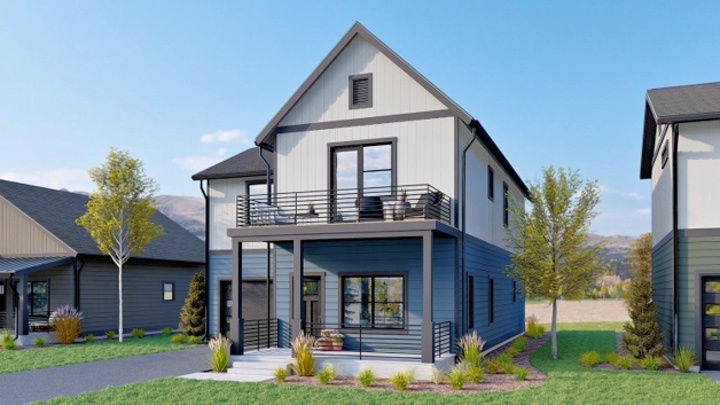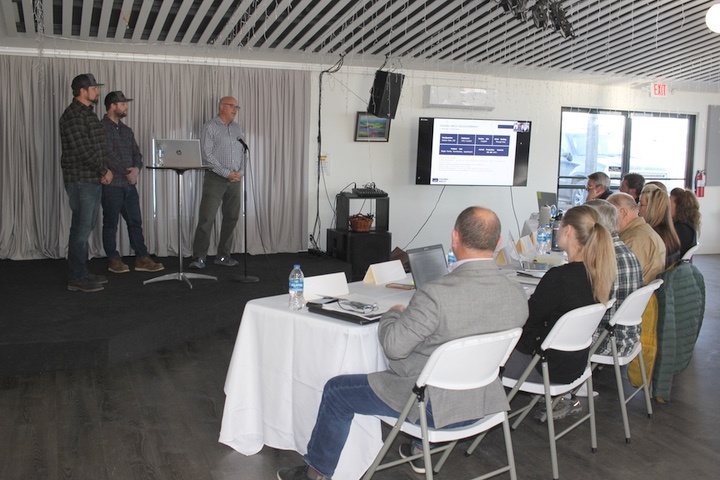Nine Board members — the nine members of the Pagosa Springs Community Development Corporation (PSCDC) Board of Directors — spent about two hours yesterday afternoon, listening to, and asking questions about, presentations from Pagosa-based BWD Construction and Buena Vista-based Fading West Development, the finalists in a effort to create some “attainable” housing in Pagosa Springs.
The PSCDC, last year, accepted a donation of 35 vacant tax-lien parcels in the Trails and Chris Mountain subdivisions, from the Archuleta Board of County Commissioners, and the Board made a commitment to the Pagosa community to somehow get attainable workforce housing built on those 35 vacant parcels within the next three years.
The plan calls for 10 homes to be built by the end of 2024.
The PSCDC does not build houses. Rather, the PSCDC — a 501c3 non-profit — writes grants and helps other corporations write grants, to encourage certain types of economic development in Pagosa Springs.
Thus, the two hour meeting yesterday, to hear from Fading West and BWD. Both corporations presented themselves as willing to build 10 homes in 2024, to be sold to deserving families.
The two companies exhibited very different approaches to the 10-home solution.
From the Fading West website:
Fading West began in 2016 with what they thought would be a ‘one-off’ development project called The Farm at Buena Vista. Named after a Switchfoot album that our Founder and CEO was particularly fond of, Fading West was created to ensure that the prospect of attainable homeownership did not fade away for people living and working in the mountain towns of Colorado and across the Western United States.
Fading West has continued to evolve, and is now a fully integrated design, development, manufacturing, construction, and property management company rooted in LEAN processes and a culture of continuous improvement. But our commitment to attainable housing for the workforce has not changed…
From the very beginning, Fading West understood modular construction to be a solution to help reduce overall project costs and significantly increase construction efficiency.
A recent McKinsey & Company report highlights how productivity in the construction industry has significantly lagged behind other labor-intensive industries. This wholesale lack of innovation means that the construction industry is ripe for disruption by anyone with the resources and creativity to reimagine the process.
The company is now turning out around 200 modular homes a year in a 110,000-squre-foot factory, for communities like Telluride, Breckenridge, Gunnison, Salida… claiming that their homes cost 10%-20% less than site-built homes of similar quality.
Here’s a 9News video (three minutes):
According to the three Fading West presenters, the company would like to deliver and install 10 two- and three-bedroom homes to Pagosa Springs within the next 12 months, at prices ranging from about $290,000 to $360,000.
The financial and logistical advantages to building modular homes in a factory — rather than stick-built homes on-site — are many, but one advantage is the elimination of the need for subcontractors, a class of workers slowly becoming as rare as buffalo in small rural towns. Not only does the utilitization of subcontractors increase the cost of the home, it also increases the scheduling headaches, because a subcontractor is typically working on several different projects at the same time. No one is to blame for this slightly inefficient system; it’s just the nature of the traditional construction industry.
In the Fading West homes, nearly all the work that would be handled by subcontractors is completed in the factory, before the homes are shipped.

The presentation by BWD, not surprisingly, stressed the close relationship that the Pagosa-based company has developed with a group of reliable local subcontractors — and the fact that the wages paid to those subcontractors ‘stay in the community’.
I’m sure it’s not merely the use of subcontractors that defined the higher estimated cost of the BWD homes, but the price difference between the two companies was fairly significant.
A two-bedroom BWD home was estimated at $360,000, and a three-bedroom home at $415,000.
According to the Colorado Housing and Finance Authority (CHFA) a typical working household in Pagosa Springs can afford a mortgage for a home in the $250,000 range. Additionally, the grants to help subsidize housing in Colorado are typically available for homes priced under $340,000.
In fact, the price range of $280,000 to $340,000 was specially mentioned in the Request for Qualifications to which BWD and Fading West had responded.
Obviously, BWD was aiming their 10 proposed homes at the better-paid workers in our community. But it also appears that homes in BWD’s estimated price range might not qualify for the Colorado subsidies and grants that the PSCDC hopes to apply for.
When asked how many attainable homes each company had built in the past three years, BWD CEO Rory Burnett replied that his company had built 14 ‘median income’ homes, but none had been ‘deed restricted’. Fading West replied that they had built over 200.
The public had been invited to witness the presentations, and about eight members of the public showed up at the Tennyson Event Center

At the end of two hours, PSCDC Executive Director Emily Lashbrooke announced that the Board of Directors would convene in executive session to discuss the two proposals, and that the finalists would be informed of the Baord’s decision no later than Monday, February 5.

